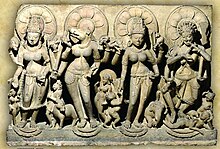
Back قنوج Arabic كنوج ARZ Канаудж Bulgarian कन्नौज Bihari কনৌজ Bengali/Bangla কন্নৌজ BPY Kanauj Catalan Kannauj (lungsod) CEB Kannauj German Kannauj Esperanto
Kannauj | |
|---|---|
City | |
 An Apsara depicted here as a dancing celestial female spirit, a medieval (12th-century) sandstone statue from Kannauj | |
| Nickname: Perfume Capital of India | |
| Coordinates: 27°04′N 79°55′E / 27.07°N 79.92°E | |
| Country | |
| State | Uttar Pradesh |
| District | Kannauj |
| Elevation | 139 m (456 ft) |
| Population (2011) | |
| • Total | 84,862 |
| Demonym(s) | Kannauji, Kannaujwale |
| Languages | |
| • Official | Hindi |
| • Regional | Kannauji |
| Time zone | UTC+5:30 (IST) |
| Vehicle registration | UP-74 |
| Website | www |
Kannauj (Hindustani pronunciation: [kənːɔːd͡ʒ]) is an ancient city, administrative headquarters and a municipal board or Nagar Palika Parishad in Kannauj district in the Indian state of Uttar Pradesh. The city's name is an evolved form of the classical name Kanyakubja.[1] In Ancient Vedic period, it was famous city of Panchala Mahajanpada and also it's capital during Panchala king Vajrayudha.[2][3]
It was also known as Mahodaya during the time of Mihira Bhoja.[4] It is situated 104 kilometres west of the state capital, Lucknow.

In Hindu epics, Kannauj or Kanyakubja was the capital of Amavasu the son of Pururavas and an ancestor of Rigvedic sage Vishwamitra.[5]
In Classical India, it served as the center of imperial Indian dynasties. The earliest of these was the Maukhari dynasty, and later, Emperor Harsha of the Vardhana dynasty.[6] The city later came under the Gahadavala dynasty, and under the rule of Govindachandra, the city reached "unprecedented glory". Kannauj was also the main place of war in the Tripartite struggle between the Gurjara-Pratihara, the Palas and the Rashtrakutas.

Kannauj was clearly the wealthiest city in early Medieval India at large[7] and the country all around Kannauj was called Āryāvarta.[8] It seems likely that Kannauj and Middle country was the place of origin of majority of migrating Brahmins throughout the medieval centuries.[9]

In 1010 A.D. Mahmud of Ghazni saw Kannauj as a "City which raised its head to skies which in strength and structure might justly boast to have no equals".[10][11]
Kannauj is famous for distilling of scents and perfumes. It is known as "India's perfume capital" and is famous for its traditional Kannauj Perfume, a government protected entity.[12]
Kannauj itself has more than 200 perfume distilleries and is a market center for perfume, tobacco and rose water.[12] It has given its name to a distinct dialect of the Hindustani known as Kannauji, which has two different codes or registers.
- ^ Rama Shankar Tripathi (1989). History of Kanauj: To the Moslem Conquest. Motilal Banarsidass Publ. p. 2. ISBN 978-81-208-0404-3. Archived from the original on 8 March 2024. Retrieved 15 November 2015.
- ^ Uttar Pradesh District Gazetteers: Farrukhabad. 39. Ballia. Government of Uttar Pradesh. 1988. p. 29.
- ^ Singh Sandhu, Gurcharn (2000). A Military History of Ancient India. Vision Books. p. 164.
- ^ "Why Gurjara is not Gujjar: A historical perspective". The Times of India. 7 August 2021. Archived from the original on 9 August 2021. Retrieved 9 August 2021.
- ^ Uttar Pradesh District Gazetteers: Farrukhabad. Government of Uttar Pradesh. 1988. pp. 21, 22.
- ^ Tripathi, History of Kanauj, p. 192
- ^ wink, Andre (2020). The Making of the Indo-Islamic World,C.700-1800 CE. Cambridge university press. p. 42.
- ^ Hussain jafri, Saiyid Zaheer (2016). Recording the Progress of Indian History. Primus Books. p. 148.
- ^ Wink, André (2020). The Making of the Indo-Islamic World C.700-1800 CE. E.J. Brill. p. 42.
- ^ Lal, Makkhan (1984). Settlement History and Rise of Civilization in Ganga-Yamuna Doab, from 1500 B.C. to 300 A.D. B R Publishing Corporation. p. 18.
- ^ Uttar Pradesh District Gazetteers: Farrukhabad. 39. Ballia. Government of Uttar Pradesh. 1988. p. 30.
- ^ a b "Life: India's perfume capital threatened by scent of modernity". The Taipei Times. 20 September 2012. Archived from the original on 17 March 2016. Retrieved 10 February 2016.
© MMXXIII Rich X Search. We shall prevail. All rights reserved. Rich X Search

